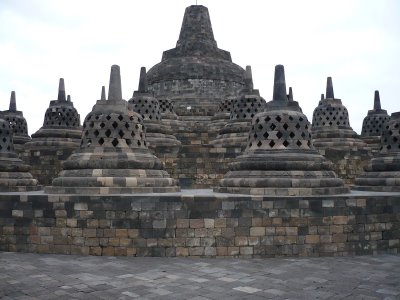The story of the life scene of the ancient Javanese people in the 8th century is found in the reliefs of Borobudur Temple in Central Java. The life scene of the ancient Javanese people in the temple consists of the life of the nobility in the palace to the common people in the countryside. There are also displayed pictures, among others, of temples, markets, architecture, animals and plants, jewelry, clothing, including vehicles such as joli (stretchers), horse-drawn carriages, riding elephants and boats.
In the entire series of stories that are carved on the walls of the giant temple, there are ten reliefs that contain images of ancient boats, with different models. In 1982, a former British Navy member named Philip Beale visited Borobudur. Starting from his intention to study traditional boats and the nautical traditions of the archipelago, Beale was then captivated by ten reliefs on the walls of Borobudur depicting ancient boats. He then plans to rebuild this ancient ship and trace the ancient maritime trade journey.
Armed with only limited data, namely five relief images, Philip Beale plans to hold an expedition to trace ancient voyages from Jakarta, Indonesia to Madagascar. If possible, the expedition would continue beyond the Cape of Good Hope on the southern tip of Africa to along the west coast of Africa. From a very careful study, the design of ship drawings was carried out by a group of experienced Indonesian traditional shipyard craftsmen. The team was formed and trained to build ships using traditional shipping technology and techniques.
At a traditional shipyard located on the Kangean Islands, which is about 60 miles (96.5 km) north of Bali, Nick Burningham, an expert on traditional Indonesian boats and marine archeology oversaw and served as a shipbuilding consultant. The ship itself was later built by Assad Abdullah al-Madani, an experienced Indonesian traditional boat builder. Together with his colleagues, Assad, armed with only a few drawings and a small-scale model of the Borobudur ship from balsa wood made by Nick Burningham, managed to recreate this ancient ship.
The real form of the ship from the Borobudur relief was inaugurated at Benoa Harbor, Bali on July 15, 2003, by the Minister of Tourism and Culture of the Republic of Indonesia during the leadership of President Megawati Soekarnoputri, I Gede Ardika, together with Philippe Delanghe, a cultural specialist at UNESCO’s Jakarta office.
The ship’s task was very heavy, because it was asked to take a trail trip along the Kayumanis Route, just as did the sailors of the Syailendra dynasty, around the 7th to the 13th centuries ago. When the 5th President of the Republic of Indonesia Megawati Soekarnoputri released the departure of this wooden ship at Marina Ancol Beach, Jakarta on August 15, 2003, some of the public and maritime experts wondered whether this ship could cross the Indian Ocean, circle the Cape of Good Hope, then along the Atlantic Ocean for heading to a port in the city of Accra, Ghana, Africa?
At that time, there was no doubt on the face of the first woman president of the Republic of Indonesia. Optimism also surfaced on the face of Marine Captain I Gusti Putu Ngurah Sedana, an officer of the Indonesian Navy’s Military Naval Command (Kolinlamil), who led the expedition of the “Cinnamon Route” along with his 12 crew. Megawati’s instincts as the leader of the country at that time proved correct. The mission of the ship which he named Samudra Raksa – meaning “defender of the ocean” – was perfectly executed. At exactly 09.30 local time or 16.30 WIB, Monday (23/2/2004), the Borobudur Samudra Raksa ship anchored in the waters off the coast of Tema Port, Accra, the capital of Ghana, which is located on the southwest coast of the African continent.
It marked the end of the long and historic voyage of a ship that had previously doubted its ability to complete such a perilous expedition. Until arriving at the port in Accra, Samudra Raksa has to sail 11,000 nautical miles (20,372 kilometers), across the Indian Ocean and the Atlantic. The momentum coincided with six months and eight days since President Megawati Soekarnoputri let Samudra Raksa depart at Marina Beach. Fantastic, epic, and proud are the most popular expressions, responding to the expedition of the cinnamon trade route (The Cinnamon Route), which is similar to the actions of the Indonesian ancestors 12 centuries ago.
The Borobudur-Samudra Raksa crew, who underwent The Cinnamon Route expedition through their official website, www.borobudurshipexpedition.com, admitted that the ship’s journey actually had a delay of 1.5 months. It was said that in the original schedule, the ship would arrive in Accra, Ghana, within four months of traveling, via the Jakarta-Seychelles-Madagascar-Cape Town-Accra route. The delay occurred due to the ferocity of nature, especially when going through the toughest stages of Madagascar-Cape Town which had to circle the Cape of Good Hope. At that time, although it was not planned, sea captain I Gusti Putu Ngurah Sedana, as the captain of the ship, was forced to order the crew several times to dock the ship in a number of ports. Among them, in Mossel Bay and Port Elizabeth, South Africa, due to storm disturbances and dead winds.
Until the end of the trip, the expedition leader who was a former member of the Royal Navy (British Royal Navy), Philip Beale, brought in 27 people from various nations. Some of them were replaced in turn in Seychelles and Durban, South Africa. Ten of them were participants from Indonesia, including the ship captain and three boat builders from Kangean Island, Sumenep Regency, East Java, who helped build the ship from scratch, namely Julhan, Muhammad Abdu, and Sudirman.
Since the arrival of the Borobudur ship at the port of Accra City in the morning, until almost midnight, around 200 people who attended the thanksgiving event did not go home at all. Among them were Minister of Tourism and Culture I Gede Ardika, initiator of the Philip Beale Cinnamon Path Expedition, ship crews, officials and staff of the Indonesian ambassador in Ghana, and the international community.
Mix and stir the expressions on the faces of the participants in the event. Some even still showed a face of disbelief when Borobudur-Samudra Raksa finally managed to escape the ferocious attack of two oceans, namely the Indian Ocean and the Atlantic Ocean, and completed the mission perfectly. For them, the success of the expedition was like a dream come true.
A sense of amazement and disbelief also came to most of the nation’s children who knew that the Samudra Raksa expedition split the ocean. Moreover, the coverage of the expedition, from the start of planning, ship building, to the ship’s journey on a dangerous mission, was classified as minimal. The business world also responded to distrust. Most of them refuse to be involved as a sponsor of the transoceanic journey. Of the 30 sponsors mentioned on the official website of the Borobudur Ship Expedition, only two sponsors came from Indonesia, namely the Indonesian Ministry of Culture and Tourism and the Park Lane Hotel, Jakarta.
This maritime journey is indeed not something easy for Samudra Raksa. Because the size of the ship is relatively small. With a length of only 18.29 meters and a width of 4.25 meters, the ship is actually no match for the Indian Ocean or the Atlantic Ocean which is known to be ferocious. The story of the epic Borobudur-Samudra Raksa boat trip has really attracted the world’s attention. For quite a long time, the expedition at the same time made the eyes of the world have to return to a giant temple site in Kedu Village, Magelang, Central Java called Borobudur. Previously, Borobudur Temple was also a very strong cultural magnet when Unesco designated Borobudur Temple as a World Cultural Heritage after the completion of the temple complex restoration project in 1991.
Based on the great confidence of collaborators, especially the support of the Indonesian government under the leadership of the 5th President of the Republic of Indonesia, Megawati Soekarnoputri, in creating intelligent maneuvers by juggling with a heritage to become a super strong magnet, it was proven that this step was able to attract the attention of international tourism. The “Cinnamon Path” expedition which was the result of the collaboration of a number of parties, finally had a truly extraordinary impact.
For all citizens of the nation, the expedition was not only a beautiful moment, but also a place to gain experience and strengthen one’s identity as a nation, through the reintroduction of history and past glory. The Cinnamon Expedition, which also involves the international community, also provides reinforcement for the continuity of the world of tourism in the country. The story of the Borobudur-Samudra Raksa double-sided ship has also been a success all over the world. Are you interested in this article? Come on, get interesting information from Indonesiar.com.































